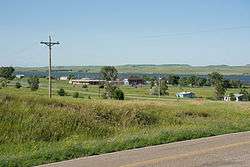Cannon Ball, North Dakota
| Cannon Ball, North Dakota | |
|---|---|
| CDP | |
|
Cannon Ball River | |
 Location of Cannon Ball, North Dakota | |
| Country | United States |
| State | North Dakota |
| County | Sioux |
| Area | |
| • Total | 96.8 sq mi (251 km2) |
| • Land | 88.3 sq mi (229 km2) |
| • Water | 8.4 sq mi (22 km2) |
| Population (2010)[1] | |
| • Total | 875 |
| • Density | 9.0/sq mi (3.5/km2) |
| Time zone | Central (CST) (UTC-6) |
| • Summer (DST) | CDT (UTC-5) |
Cannon Ball (Arikara: načiiʾuuháwi [načii’uuháWI], sananaapíkat [sananaapíkAt];[2] Lakota: Íŋyaŋwakağapi[3]) is a census-designated place (CDP) in Sioux County, North Dakota in the United States and on the Standing Rock Indian Reservation. It sits in the northeastern part of Sioux County where the Cannonball River meets Lake Oahe of the Missouri River. The population was 875 at the 2010 census.[1]
Geography
Cannon Ball is located at 46°14′58″N 100°38′19″W / 46.249361°N 100.638672°WCoordinates: 46°14′58″N 100°38′19″W / 46.249361°N 100.638672°W.[4]
According to the United States Census Bureau, the CDP has a total area of 96.8 square miles (251 km2), of which, 88.3 square miles (229 km2) of it is land and 8.4 square miles (22 km2) of it (8.69%) is water.
Demographics
| Historical population | |||
|---|---|---|---|
| Census | Pop. | %± | |
| 1990 | 702 | — | |
| 2000 | 864 | 23.1% | |
| 2010 | 875 | 1.3% | |
| U.S. Decennial Census | |||
As of the census[5] of 2000, there were 864 people, 197 households, and 171 families residing in the CDP. The population density was 9.8 people per square mile (3.8/km²). There were 208 housing units at an average density of 2.4/sq mi (0.9/km²). The racial makeup of the CDP was 5.32% White, 94.21% Native American, 0.12% Pacific Islander, 0.23% from other races, and 0.12% from two or more races. Hispanic or Latino of any race were 2.08% of the population.
There were 197 households out of which 56.9% had children under the age of 18 living with them, 38.6% were married couples living together, 35.0% had a female householder with no husband present, and 12.7% were non-families. 11.2% of all households were made up of individuals and 2.0% had someone living alone who was 65 years of age or older. The average household size was 4.35 and the average family size was 4.56.
In the CDP the population was spread out with 46.4% under the age of 18, 11.2% from 18 to 24, 23.5% from 25 to 44, 15.3% from 45 to 64, and 3.6% who were 65 years of age or older. The median age was 20 years. For every 100 females there were 92.4 males. For every 100 females age 18 and over, there were 86.7 males.
The median income for a household in the CDP was $19,265, and the median income for a family was $18,583. Males had a median income of $21,875 versus $17,250 for females. The per capita income for the CDP was $5,717. About 49.7% of families and 50.9% of the population were below the poverty line, including 58.3% of those under age 18 and 8.6% of those age 65 or over.
See also
- Sioux (Dakota)
- Two Bear
- Upper Yanktonai Sioux
- Standing Rock Indian Reservation
References
- 1 2 "2010 Census Redistricting Data (Public Law 94-171) Summary File". American FactFinder. United States Census Bureau. Retrieved 2 May 2011.
- ↑ "AISRI Dictionary Database Search-- Arikara. Prototype version". Retrieved 2012-07-08.
- ↑ Ullrich, Jan, ed. (2011). New Lakota Dictionary (2nd ed.). Bloomington, IN: Lakota Language Consortium. p. 877. ISBN 978-0-9761082-9-0. LCCN 2008922508.
- ↑ "US Gazetteer files: 2010, 2000, and 1990". United States Census Bureau. 2011-02-12. Retrieved 2011-04-23.
- ↑ "American FactFinder". United States Census Bureau. Retrieved 2008-01-31.
| |||||||||||||||||||||||||||||||||

